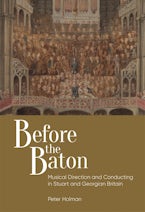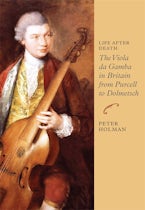
Title Details
432 Pages
23.4 x 15.6 cm
16 b/w illus.
Series: Music in Britain, 1600-1900
Series Vol. Number:
6
Imprint: Boydell Press
Life After Death: The Viola da Gamba in Britain from Purcell to Dolmetsch
- Description
- Contents
- Author
- Reviews
New research throws light on the history of the viol after Purcell, including its revival in the late eighteenth century through Charles Frederick Abel.
It is normally thought that the bass viol or viola da gamba dropped out of British musical life in the 1690s, and that Henry Purcell was the last composer to write for it. Peter Holman shows how the gamba changed its role and function in the Restoration period under the influence of foreign music and musicians; how it was played and composed for by the circle of immigrant musicians around Handel; how it was part of the fashion for exotic instruments in themiddle of the century; and how the presence in London of its greatest eighteenth-century exponent, Charles Frederick Abel, sparked off a revival in the 1760s and 70s.
Later chapters investigate the gamba's role as an emblem of sensibility among aristocrats, artists, and intellectuals, including the Countess of Pembroke, Sir Edward Walpole, Ann Ford, Laurence Sterne, Thomas Gainsborough and Benjamin Franklin, and trace Abel's influence and legacy far into the nineteenth century. A concluding chapter is concerned with its role in the developing early music movement, culminating with Arnold Dolmetsch's first London concerts with old instruments in 1890.
PETER HOLMAN is Professor of Historical Musicology at Leeds University, and director of The Parley of Instruments, the choir Psalmody, and the Suffolk Villages Festival.
It is normally thought that the bass viol or viola da gamba dropped out of British musical life in the 1690s, and that Henry Purcell was the last composer to write for it. Peter Holman shows how the gamba changed its role and function in the Restoration period under the influence of foreign music and musicians; how it was played and composed for by the circle of immigrant musicians around Handel; how it was part of the fashion for exotic instruments in themiddle of the century; and how the presence in London of its greatest eighteenth-century exponent, Charles Frederick Abel, sparked off a revival in the 1760s and 70s.
Later chapters investigate the gamba's role as an emblem of sensibility among aristocrats, artists, and intellectuals, including the Countess of Pembroke, Sir Edward Walpole, Ann Ford, Laurence Sterne, Thomas Gainsborough and Benjamin Franklin, and trace Abel's influence and legacy far into the nineteenth century. A concluding chapter is concerned with its role in the developing early music movement, culminating with Arnold Dolmetsch's first London concerts with old instruments in 1890.
PETER HOLMAN is Professor of Historical Musicology at Leeds University, and director of The Parley of Instruments, the choir Psalmody, and the Suffolk Villages Festival.
Introduction
'Musitians on the Viol de Gamba': Professional Players in Restoration England
'The Noble Bass Viol': Amateur Players around 1700
'Per la Viola da Gamba': Immigrants in Early Eighteenth-Century London
'Awake my Cetra, Harp and Lute': John Frederick Hintz and the Cult of Exotic Instruments
'A Solo on the Viola da Gamba': Charles Frederick Abel as a Performer
'Composed to the Soul': Abel's Viola da Gamba Music
'The Heart of Sensibility': Writers, Artists and Aristocrats
'The Art of Playing it has never Died Out in this Country': Abel's Competitors, Followers and Successors
'Performed upon the Original Instruments for which it was Written': the Viola da Gamba and the Early Music Revival
'Musitians on the Viol de Gamba': Professional Players in Restoration England
'The Noble Bass Viol': Amateur Players around 1700
'Per la Viola da Gamba': Immigrants in Early Eighteenth-Century London
'Awake my Cetra, Harp and Lute': John Frederick Hintz and the Cult of Exotic Instruments
'A Solo on the Viola da Gamba': Charles Frederick Abel as a Performer
'Composed to the Soul': Abel's Viola da Gamba Music
'The Heart of Sensibility': Writers, Artists and Aristocrats
'The Art of Playing it has never Died Out in this Country': Abel's Competitors, Followers and Successors
'Performed upon the Original Instruments for which it was Written': the Viola da Gamba and the Early Music Revival
"[O]utstanding research [...] a valuable reference book that I will no doubt consult again and again." EIGHTEENTH CENTURY MUSIC
"[A] fascinating study that has significantly enlightened the dark ages of a much loved instrument." MUSIC & LETTERS
"[Eine] spannenede und extreme informative Abhandlung." VIOLA DA GAMBA
"This is a book not only for those interested in the viola da gamba but also in musical social history in Britain from the 17th to the end of the 19th century. It is rich in scholarly detail and is entertaining to read." STRINGENDO
"[B]eautifully presented and Holman's lucid and elegant prose is a joy to read. [...] This is a book suitable for players and scholars alike, which makes a valuable contribution to our understanding of the viol; I recommend it wholeheartedly." EARLY MUSIC
"[This] volume draws on a truly vast range of documentation [...] and is written in an unpretentious, descriptive prose [...] the coverage is impressive and its result will be of use in many connections: indeed a reference work." MUSICAL TIMES
"There are so many new insights into the life of the viol in this book [...] that the reader is put on a steep learning curve and sent on a truly fascinating journey through the centuries. [...] it can easily be used as a reference book by delving into the sub-chapters or consulting the very comprehensive index, or be read like an exciting novel." THE CONSORT
"No one better could have written this book, which is superb. [...] Applying to the task his extensive research, close acquaintance with the instruments and their music, stellar command of the literature, and lively narrative, Holman demonstrates the extent to which viol playing in Britain survived." CHOICE
"Holman has the knack of finding interesting information and writing interestingly about it. [...] It is a book to dip into." EARLY MUSIC REVIEW
Hardcover
9781843835745
November 2010
£80.00 / $115.00
Paperback
9781843838203
April 2013
£24.99 / $36.95
Ebook (EPDF)
9781846158988
November 2010
£24.99 / $29.95
Title Details
432 Pages
2.34 x 1.56 cm
16 b/w illus.
Series: Music in Britain, 1600-1900
Series Vol. Number:
6
Imprint: Boydell Press










